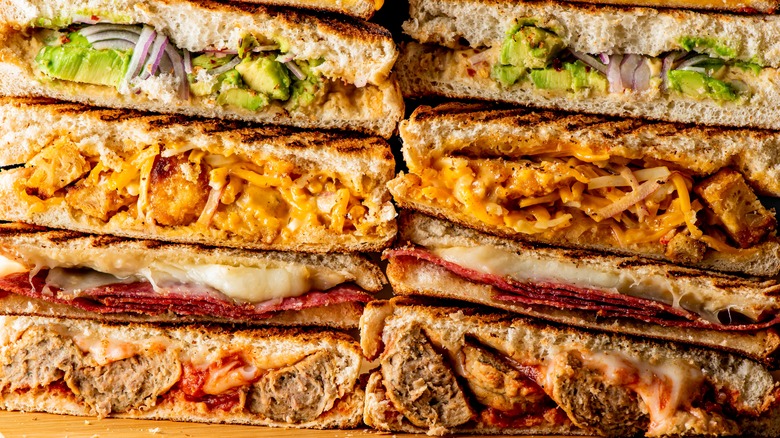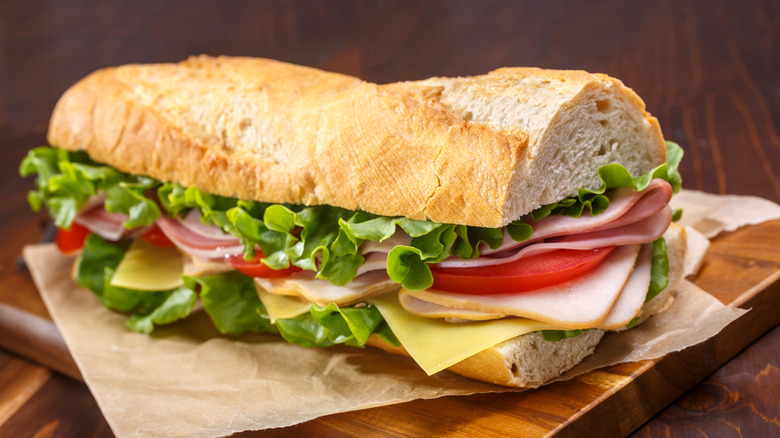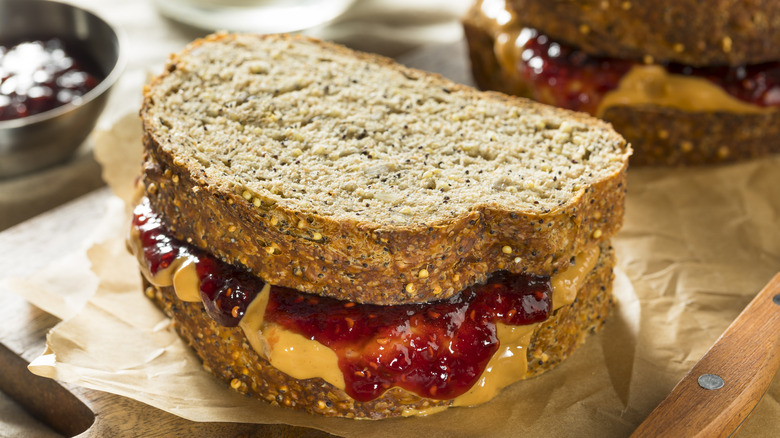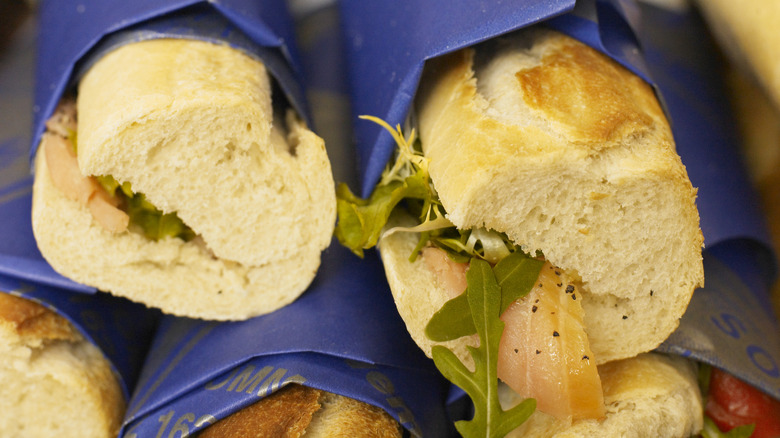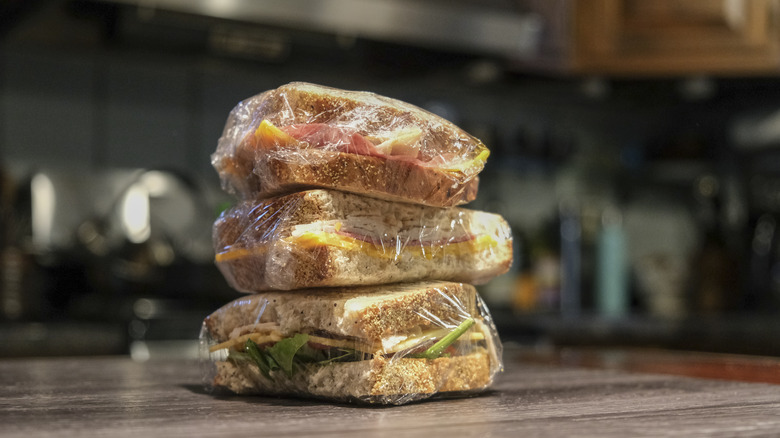The Best (And Worst) Ways To Prep Freezer-Bound Sandwiches
Freezing sandwiches can be a fantastic option for people who are always on the go or for those who like to meal prep their lunches. It's a quick and easy way to have a ready-to-go meal without the hassle of having to make something fresh every day. Freezing sandwiches can also be a great way to save money on lunches because buying pre-made sandwiches regularly can become expensive rather quickly. By freezing your own, you can save money while enjoying delicious and nutritious meals.
Additionally, freezing sandwiches can be a great way to reduce food waste too, as you can use up any leftovers or ingredients you have on hand. Plus, it's incredibly convenient — you can simply grab a sandwich from the freezer in the morning and it will be thawed and ready to eat by lunchtime. Whether you're looking for a quick meal during a busy schedule or an easy way to meal prep for the week, freezing sandwiches is definitely worth considering.
With a few tips and a bit of insight in choosing the best ingredients that can withstand the freezer, you can be well on your way to making the most of frozen sandwiches.
Carefully select the best bread
When it comes to freezing sandwiches, choosing the right type of bread can make all the difference. And one important tip for freezer sandwiches is to start with sturdy bread. Sturdier, crusty loaves of bread like sourdough, ciabatta, and baguettes tend to work best as they can withstand the moisture that the sandwich will sweat while thawing. These breads have a denser texture and a chewier crust, which means they won't become too soggy or fall apart during the freezing and thawing process.
Avoid soft or fluffy bread like brioche and white or wheat loaf bread, as it tends to become soggy when frozen. Those types of bread will also absorb moisture from the ingredients inside the sandwich too. This will cause the bread to lose its texture and become mushy.
Another tip is to lightly toast the bread before freezing, as this can help it maintain its structure and prevent it from becoming too soggy. By choosing the right type of bread and following these tips, you can ensure that your frozen sandwiches are delicious and satisfying, even after thawing.
Cheeses in frozen sandwiches
When it comes to freezing sandwiches, choosing the right cheese is just as important as choosing the right bread. Certain types of cheeses work better than others because some cheeses can become rubbery or gritty when thawed. Good options for freezing include hard cheeses like cheddar, Swiss, and provolone, as well as semi-hard cheeses like gouda or Monterey Jack. These cheeses have a firmer texture that can withstand freezing and thawing without losing their flavor or texture.
Soft cheeses like brie, camembert, or goat cheese should be avoided, as they tend to become too runny and lose their structure when frozen. Additionally, the likes of feta or blue cheese can become crumbly and grainy when thawed, which can affect the texture of your sandwich. When in doubt, it's always a good idea to test a small portion of the cheese before freezing all of it to ensure that the cheese will thaw properly.
Another way to avoid the negative effects of frozen cheese is to leave it out of the sandwich when preparing it for the freezer. Cheese can sweat as it comes to room temperature passing more moisture onto the bread. That means it could make the whole sandwich soggy if you don't use the right ingredients. Instead, consider adding cheese after the sandwich has thawed.
Which sandwich meats to freeze
When it comes to freezing sandwiches, choosing the right type of meat is important for both flavor and texture. Some meats freeze better than others, and it's important to choose the right ones to avoid ending up with a soggy, unappetizing sandwich. Good options for freezing include cooked meats like chicken and roast beef or even deli meats such as turkey and ham.
The best meats for frozen sandwiches are actually cured meats such as salami or pepperoni. These meats have a firmer texture and lower water content. That means they will not become mushy when thawed. They also tend to have a longer shelf life than raw meats, which can spoil more quickly in the freezer.
Freezing other sandwich fillings
Freezing sandwiches can be a great option for meal prep, and choosing the right sandwich fillings is crucial for ensuring that your sandwiches are both delicious and easy to thaw. Good options for freezing include peanut butter and other varieties of nut butter, chicken salad, and tuna salad. These fillings tend to have a firmer texture and hold up well in the freezer, maintaining their flavor and consistency when thawed. Other good options include tinned fish, hummus, and cream cheese with various mix-ins like herbs or nuts.
However, it's important to avoid fillings that can become too watery or lose their texture when frozen, such as cooked eggs. Raw vegetables like bell peppers, sliced tomatoes, cucumbers, or carrots can also become too tough or rubbery when thawed, so it's important to cook or blanch them beforehand. By choosing the right fillings and following proper freezing and thawing techniques, you can enjoy a delicious, perfectly thawed sandwich every time.
Tips for freezing sandwiches
Freezing sandwiches can be a great way to save time and money, but it's important to do it right to avoid ending up with a soggy or dried-out sandwich. First, it's important to prepare the sandwich as you normally would, making the sandwich with freezer-safe ingredients using Tasting Table's tips.
When assembling the sandwich, be sure to wrap it tightly in plastic wrap or aluminum foil. This will help prevent freezer burn, drying out, and keep the sandwich fresh. The sandwiches should also be placed inside an airtight container. Label the sandwich with the date it was made and what's inside, so you know what you're thawing later on. Once the sandwiches have been prepared and frozen, they will keep for up to two months in the freezer.
Defrosting frozen sandwiches
Lastly, it is just as important to know how to thaw frozen sandwiches. If the pre-made sandwiches are not properly defrosted, they still run the risk of becoming soggy. That's why you need to plan ahead and follow one simple step.
When you are ready to defrost the sandwich, the best way is to remove it from the freezer and place it in the refrigerator overnight. This allows the sandwich to thaw slowly and evenly, minimizing the risk of any of the ingredients becoming too soft or soggy. If you're short on time, you can defrost the sandwich in the oven at a low temperature. But note that using an oven will dry the sandwich out a bit.
So, with the right tools and ingredients, you can quickly and easily meal prep plenty of sandwiches to get through busy days. Just be prepared to treat the quick and easy meal with the same care that you would other pre-made, frozen dishes.
